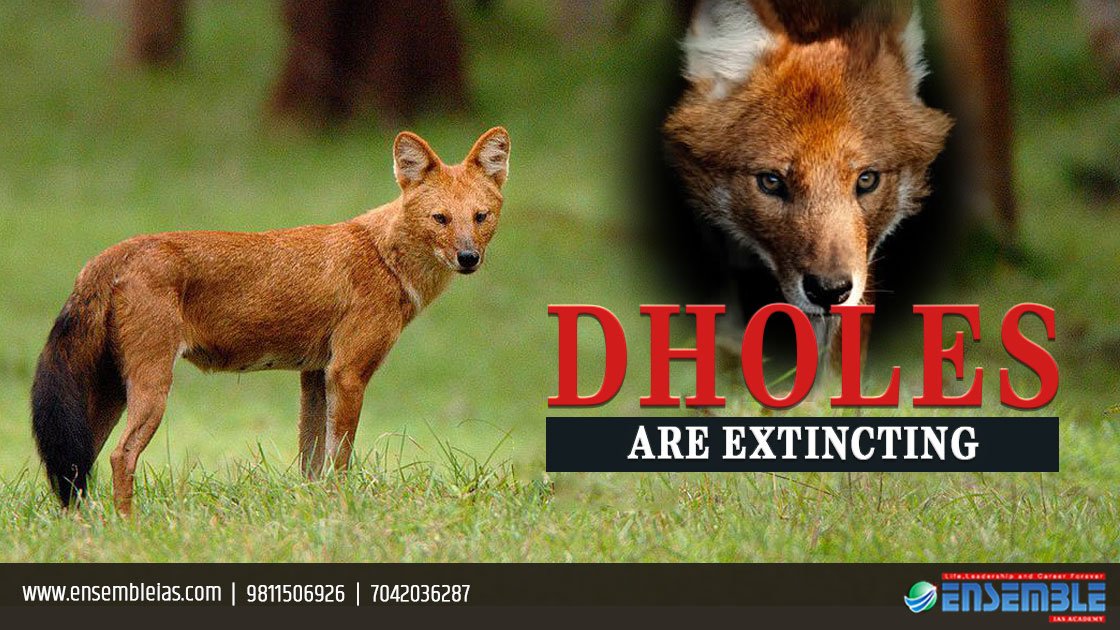Dholes are extincting : Human beings have made a lot of progress in the past decades. Consequently our equation with the environment has also changed. However, this change has not been so progressive.
Since industrial times, humans have led the world to achieve massive growth of industries, even agricultural development resulting in tremendous food production having inherent environmental consequences. Therefore, while creating habitats for ourselves, we have snatched the habitats and territories of countless species.
One such species being Dholes, also known as Wild dog or the Whistling dog.

Dhole is a canid, which is native to Central, South, East and South-East Asia.
India has the largest population of Dholes in the world. These carnivores are found in biodiversity rich Western Ghats along with some parts of Central India as well as North-Eastern India. Dhole or dholes are always seen hunting in packs. The pack is generally led by an Alpha pair, which is also primarily responsible for reproduction. They hunt and work together as a team. In India, dholes are given Protected Status under Schedule II of the Wildlife Protection Act 1972.
Dholes are considered ‘extremely endangered’ in the International Union for conservation of Nature Red List of Endangered species. It is unfortunate that only 1000-2000 adult populations of dholes are left today. It is a serious matter of concern that the dhole population has disappeared by 82% of their former range according to a study conducted in 2019.
It is also noteworthy that dholes have their key habitat in the forests of Western Ghats and despite this area being reserved, the population has decreased. It presents a grim picture of the state of conservation of these forests.
Reasons for Dholes’ diminishing numbers
The diminishing numbers are due to a multitude of factors such as- 
- Firstly, loss of habitat – due to continuous clearing of forests due to infrastructure projects, grazing or agriculture.
-
- Loss of habitat not only directly affects the population of a species but also affects it indirectly by displacing the prey population, thus disrupting the food chain.
- Secondly, loss of prey population and competition – Dholes generally feed on herbivores like deers, buffaloes, goats or pigs.
- The decrease in numbers of these prey species may be due to competition by other species like tigers, etc.
- Thirdly, the wild dogs can catch lethal diseases like rabies from domestic and feral dogs.
- Other reasons include poisoning as they hunt livestock too, therefore villagers often poison dholes in order to protect their livestock. It is noteworthy that although dholes do not have many predators, still they are few. This can be attributed to the fact that their breeding population (adult dholes) is very less.
A comprehensive strategy for dholes’ conservation
Hence, a comprehensive strategy is required to conserve the wild dogs, protect their numbers from falling further down as well as take measures to increase their population.
Since, India is the only country with the largest population of dholes, some project initiative taking inspiration from a project like Project Tiger, which has been successful in bringing up the numbers of tigers is important. It is important to protect the wild dogs from extinction because every creature is a vital part of the ecosystem. If dholes disappear, it might collapse South-Asian ecosystems.
Strategies must be planned by taking multiple stakeholders into discussion so as to conserve their meta-populations since dholes are pack-living social carnivores. They tend to move or within these groups. Therefore, conservation plans must be made by taking connected populations across different regions and landscapes into consideration.
Steps for conservation
- It is noteworthy that conservation efforts of Project Tiger also benefited dhole population too in Western Ghats as the region was declared protected.
- It is equally important that local communities are also involved in conservation strategies. The knowledge and the experience of such communities are not only valuable but sustainable too.
- Also, more studies must be undertaken to learn about dholes since there is little awareness about them.
- Breeding centres like Indira Gandhi Zoological centre must be developed not only for dholes but for other such species too.
- Other techniques like movement tracker, habitat ID, etc must be undertaken on a serious scale to study more about their movements, lifestyle and habitats.
Such measures will help in increasing their numbers and protecting them too.
AUTHOR- SURAMYA SHARMA Category:- Environment and Ecology
For more details : Ensemble IAS Academy Call Us : +91 98115 06926, +91 7042036287
Email: [email protected] Visit us:- https://ensembleias.com/
#extremely_endangered #save_dholes #protect_wildlife #stop_deforestation #blog #geography_optional #upsc2020 #ias #k_siddharthasir #Government_of_India #india #studyabroad #geography #upsc #bhugol #government #news #dailynews #gk #dailyquiz #editorial

